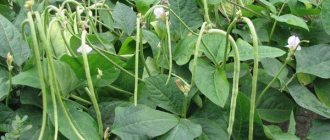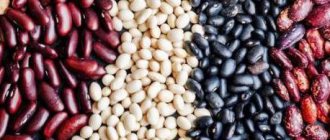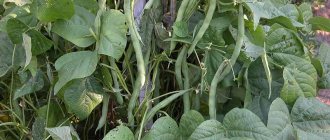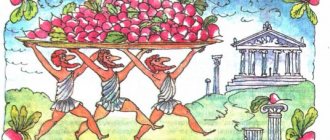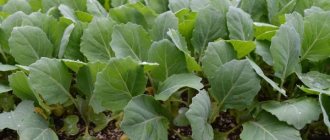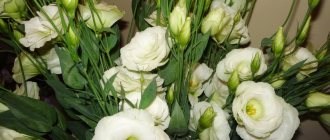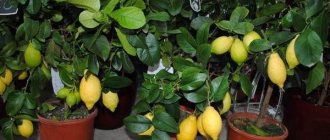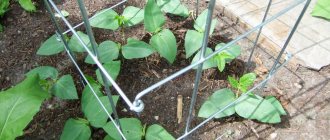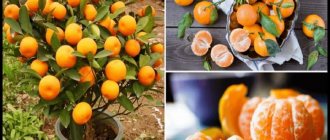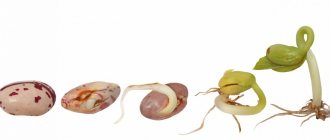What types of pod crops are there: description
Beans are divided into several types according to different characteristics.
Bush runner beans, climbing and semi-climbing :
- Bush beans are characterized by an abundant harvest.
- Climbing and semi-climbing ones have the appearance of vines that grow upward. They are sometimes used to decorate a site.
Shelling, asparagus and semi-sugar varieties:
- In shelled varieties, the beans are separated from the pods; the pods are not eaten.
- Asparagus remains soft throughout the entire growth period and is consumed together with the pod.
- Semi-sugars are eaten completely when young; after full ripening, the pod is separated.
Hulling varieties are divided into types according to the shape of the beans:
- fava;
- cowpea;
- chali;
- flageolet;
- pinto;
- black;
- kidney;
- Lima;
- navi.
Seeds for Siberia
For Siberia, early types of this crop with a small green mass are chosen.
The best varieties are considered:
- Caramel.
- Neringa.
- Mascott.
What to plant in the Urals?
Growing beans in the Urals is problematic; they love warmth.
However, gardeners were able to grow several varieties, adhering to the rules of care. Need to be planted after frost. Reference !
The seedlings must be additionally protected with film. For a good harvest in the fall, introduce mineral and organic fertilizers. Bean varieties :
- Anfisa.
- Darina.
- Gold of Siberia.
- Nika.
- Solar.
Seeds for the Middle Zone and Moscow Region
In this region, beans are grown for both food and decorative purposes. In the Moscow region, seeds of the best climbing or bush varieties are used.
Here, according to the State Register, it is recommended to grow beans:
- Antoshka.
- Lacemaker.
- Butter king.
- Purple Queen.
- Sweet courage.
Growing green beans at home
If you don’t have a garden plot, green beans can also be grown on the balcony. And not only bush varieties, but also climbing varieties. They can be a very impressive decoration. But it is still better to give preference to bush beans - they are earlier ripening, the crop ripens en masse. Bona, Blue Lake, Neringa, and Sweet Kurazh varieties are well suited for the balcony. The most decorative beans are Violetta, Golden Neck, and Raspberry Bell.
Green beans are plants with short daylight hours: they love light, but for no more than 12 hours a day. Plants do not need additional lighting in spring and summer.
The root system of asparagus beans is superficial and not particularly developed. She doesn't need deep, large containers at all. An ordinary flower pot with a volume of 2–3 liters is enough for a bush and 30–35 liters for a vine. The main thing is that the substrate is sufficiently nutritious. It is best to mix regular garden soil or universal soil for indoor plants with humus in a 2:1 ratio. The latter not only ensures fertility, but also reduces soil acidity. To prevent diseases, add a little crushed chalk or activated carbon.
Sprouted seeds are planted in pots in the first half of May. The plants will bloom in about a month and a half, and the harvest begins in another 2–2.5 weeks.
Bean seedlings are watered frequently, but moderately, as the top layer of soil dries out. After the appearance of the second pair of true leaves, watering is stopped, resuming at the time the buds appear. Fertilizers are applied no more than once every two weeks. This can be an infusion of wood ash or special products for indoor plants (without nitrogen, but with a high concentration of potassium and phosphorus).
The most delicious yellow one
Used to decorate the area. The herbaceous stem forms shoots on the sides. It has a taproot system. Yellow flowers appear on the plant during the flowering period. The length of the pod is 10 cm. One pod can contain up to 7 beans. For a good harvest, the tops are regularly cut off.
Early varieties are harvested after 50 days, medium ones - at 70 days, and late ripening ones - at 100 days. The pods are picked during milky ripeness . Their length is 20 cm. Flexible, the beans are small inside. Used for cooking and canning.
Reference ! The beans do not last long, even in the refrigerator they wither the next day.
No fibers
Fiberless beans are valued for their high yield. It is frozen and prepared in many dishes. The fruits must be picked young, before they become coarse and lose their taste.
Blue Lake
Climbing garland of green beans, without coarse fibers, productive, very early ripening. Ripening occurs in 50-56 days. The plant is 1.5 m tall and needs strong support. Long pods, rich green color, 16 cm. Medium-sized white grains, delicate in taste.
Loves light and high humidity . Prefers loose soil rich in humus. It is resistant to diseases, especially to the mosaic virus. It is characterized by intensive growth and abundant harvest. Suitable for freezing during milk ripeness.
Video about the characteristics of this type:
Butter King
Ripens early, on the 50th day. Sow in late May early June, when the soil warms up to 15°C. An erect bush with a compact shape, up to 40 cm. The pods are yellow-golden, large and long - 25 cm, diameter up to 2 cm. The blades are not fibrous and do not have a parchment layer. Excellent immunity to diseases. Grows well in dry soil and does not wither.
Reference ! Can be planted on loamy soils, but the best soil is sandy loam, rich in lime.
The harvest is harvested by mid-summer. The pods are picked as they ripen to stimulate productivity. Stable harvest of up to 1.5-2 kg of beans per 1 sq. m.
Malachite
Early ripe green beans . A compact bush with an average number of leaves, 35-45 cm, strewn with beans. The flowers are white. Ripens in 50-55 days. The lower pod is at a height of 10-13 cm. Green in color, slightly curved in shape, without a parchment layer and fibers.
The length of the pod is 12-14 cm. The beans are elliptical in shape, without veins, and white in color. Used for freezing and canning.
Amber
Mid-season green beans . Bushes of medium height or tall. Slightly wrinkled leaves, from light green to green shades, flowers are violet-pink, medium in size. Ripe pods are slightly curved or curved. There are no parchment layers or fibers.
The fruits are medium length, light yellow in color, heart-shaped in cross section. Seeds are bud-shaped, light brown in color with weak veins. The heat-loving variety does not like large amounts of moisture. Has excellent taste.
Features of cultivation
The timing of planting asparagus varieties on a site is greatly influenced by weather conditions. In the south of the country in regions with a warm climate, sowing begins in early May. In the northern regions, they are waiting for warm weather to set in so that return frosts do not destroy heat-loving plants.
Important!
In order for the seeds to begin to germinate, the soil must be heated to a temperature of +15 degrees. If there is a high probability of frost, the beds with beans are covered with film or other covering material.
Before sowing seeds, the soil is carefully dug up and at the same time the area is cleared of weeds and remains of other plants. During the formation of the beds, the soil is enriched with mineral complexes or organic matter. Seeds are planted to a depth of 5 cm, leaving 20 cm between individual plants and 40 cm between rows. If this rule is not followed and the seeds are sown closer, a lack of space is created, the plants intertwine with each other, and the number of fruits decreases.
Caring for beans involves periodic irrigation, removing weeds and loosening the rows. If disease or damage to plants by insects is detected, all damaged parts are removed and burned. Plantings are treated with insecticides. To prevent insect attacks at the sowing stage, seed material is treated with special means.
The pods are picked at the stage of milky ripeness, until they are completely ripe. It's better to pick them in the morning. Then the leaves have a lot of moisture, they have a more delicate taste and do not open during cutting.
For freezing
There are several varieties of beans that are suitable for freezing. They do not lose their beneficial qualities when the temperature drops and retain their presentation for a long time.
Momentum
Asparagus mid-season beans . Ripens in 60 days. The bush is powerful, tall, upright. The pods are slightly curved, dark green, 13-14 cm in length. The seeds are white, with excellent taste. High-yielding, shows good results even in unfavorable conditions. At high and low temperatures it does not drop flowers.
Resistant to:
- legume virus;
- bacterial spotting;
- anthracnose.
Suitable for fresh sale and freezing.
Reference ! It can be collected for a long time; the pod does not quickly become coarse or thicken.
Thanks to its excellent qualities, the culture can be stored for quite a long time.
Serengeti
Black Eyed Peas. Early ripening, ripens in 50-55 days. Serengeti is a powerful pod-like bush plant , 50 cm in height. Emerald green leaves and white flowers. Slightly curved green pod. Length 14-16 cm, without parchment layer and fibers. The beans are white, 8-12 pieces per pod. Excellent taste, used fresh and for preservation.
Resistant to transportation. Productivity up to 2.5 kg per 1 sq. m. Resistant to:
- viral diseases;
- rust;
- anthracnose.
They are grown throughout Russia, except the Far North.
Purple
Purple bean varieties have excellent taste and are easy to care for . They contain a large amount of protein and are considered dietary. The ovaries are initially green, but after reaching 10 cm in length they change color to purple.
Dragon tongue
Dragon's Tongue is a 4 m tall vine plant used as a hedge. During growth it is necessary to tie it up. Early ripening green beans. The pod is straight, purple, 15 cm long. A spatula without a parchment layer and fibers. Loves a sunny location. Suitable for growing in open ground, does not require additional protection in the form of shelters.
Reference ! Loves soil rich in organic matter.
Has excellent taste . When heat treated it turns green. Most often used raw so as not to lose the purple color.
Bluehilda
Early ripening, ripens in 65-70 days. A powerful climbing vine, up to 3 m. The pods are soft, 20-25 cm, 10-15 cm wide. Flat-round in cross section. Before ripening, the valves become coarser and fibers appear. White oily beans have nutritional and healing properties.
Reference ! The variety is sensitive to low temperatures and must be covered with film.
The seedlings are thinned out after the first shoots appear to avoid the appearance of rot. Excellent taste. It is eaten unripe. Fresh fruits are used for side dishes and main courses. Also pickled and frozen.
Purple Queen
The variety ripens in 52-60 days. Refers to dwarf beans. The bush is small, 30-35 cm. The flowers are lilac-pink. Pods are 13-15 cm, round in cross-section. The seeds are beige or dark yellow. Resistant to low temperatures, has good immunity to diseases.
For early fruiting, they are grown under cover or in a greenhouse. It is necessary to loosen the soil and feed after germination. It is used for first and second courses. When heat treated they change color to green. Also canned and frozen.
Description of the plant, its benefits
Green beans (aka asparagus beans) are one of the oldest plants “cultivated” by man. The homeland of most of its varieties is Central and South America, but it was also well known in Ancient Egypt and China. Europeans became acquainted with the culture only in the 16th century, when the continent on the other side of the Atlantic Ocean was discovered.
Green beans have been known to mankind for thousands of years.
For a long time, green beans were used exclusively as an ornamental plant, decorating gardens and greenhouses. They began to eat it only in the 18th century. Moreover, this was considered a privilege of the aristocracy. Around the same time, green beans arrived in Russia, where they were known as “French beans.”
Green beans are:
- Bush. Compact plant that does not require support. Tolerates low temperatures better. No support needed. Fruiting is friendly.
Bush beans are a fairly compact, low-growing plant.
- Curly. The liana is on average 2.5–3 m long. To grow, you will definitely need support. Widely used in landscape design. It has higher yields and a longer fruiting period. Takes up less space - grows mainly upwards.
Planting climbing beans allows you to save space in the garden, because they grow mainly upwards
The flowers of green beans are most often white or greenish and small. Decorative varieties have been bred through selection, in which they are colored in different shades of red, purple, lilac, violet. The shape, length, and color of the pods and beans also vary greatly. They can be almost flat or round, straight or curved. The most common colors are green, yellow, purple. Less common are white, pink, and variegated beans.
Flowering beans (with the exception of some specially bred ornamental varieties) are not the most spectacular sight
The main difference between green beans and grain or shelled beans is the ability to eat the pods whole without removing the beans. They do not have a “parchment” layer and hard fibers inside. But this only applies to young pods. When they are completely overripe, they are no longer suitable for eating.
Green beans are eaten together with the pods, and it is in this form that they are sold in stores.
Green beans are included in many dishes; they are an integral part of South American and Mediterranean cuisine. Sliced pods are added to soups, salads, stews, boiled, stewed, steamed beans are served as a side dish for meat, fish, and poultry dishes. As for vegetables, it goes well with broccoli, cauliflower, eggplant, bell pepper, carrots, and tomatoes. And also with eggs, cheeses, mushrooms.
Green beans are not only healthy, but also very tasty.
Green beans don't have a great taste, but they also have great benefits for the body. Like all legumes, it is rich in easily digestible fiber and proteins. Vegetarians value it as a complete replacement for meat products. The pods are also rich in microelements. Most of all they contain potassium, magnesium, calcium, iron, zinc, phosphorus, vitamins A, E, C, group B. Green beans can be included in the menu for those who are on a diet, wanting to lose weight. It has the ability to normalize carbohydrate metabolism and is low in calories (only 23 kcal per 100 g).
Asparagus bean pods, in addition to the usual green, can be painted in more unusual colors
It has been scientifically proven that green beans help if you need to increase the level of hemoglobin in the blood, get rid of cholesterol “plaques,” and normalize the functioning of the stomach, intestines, and gall bladder. If you include beans in your diet regularly, excess salt is removed from the body (very important for swelling and joint problems), toxins, and the body’s defense against the negative effects of free radicals improves. It is also important that the product always remains environmentally friendly. When grown, green beans do not absorb harmful substances from the soil and atmosphere.
There are also contraindications. It is not recommended to use the pods during exacerbation of any chronic diseases of the stomach and intestines. And due to the high content of oxalic acid - also with urolithiasis.
Climbing beans are often used by landscape designers to create hedges and “green walls.”
Green beans are very beneficial for women. When included regularly in the diet, it:
- has a beneficial effect on the nervous system, relieving increased excitability, making emotional instability characteristic of PMS easier to bear;
- normalizes hormonal rhythm, which is vital during pregnancy and the onset of menopause;
- has a positive effect on metabolism;
- helps preserve tooth enamel, improves the condition of hair and nails;
- is an effective prevention of diseases of the genitourinary system;
- improves the condition of the skin (inflammation disappears, the activity of the sebaceous glands is normalized).
Women have long appreciated the benefits of green beans. The Egyptian queen Cleopatra, famous for her beauty and unfading youth, used it as an integral component of face masks. In Ancient Rome, powder was made from it to soften, whiten and smooth the skin.
Video: how green beans are good for the body
Green
Green varieties are characterized by tender pods . They cook very quickly and do not lose their taste. There are many green varieties.
Bona
The asparagus variety is characterized by a slow rate of seed development. Refers to mid-season varieties. Ripeness occurs at 50-60 days. The bushes are compact, 25 cm. Ripe pods are light green, slightly curved, 13.5 cm, pointed apex. The blade is not pubescent, without a parchment layer and fibers. The pods are round in cross section. The seeds are white, kidney-shaped, with a faint shine.
Stable yield, 1.0–1.4 kg/m². Resistant to diseases . Excellent taste. It is canned and frozen.
Crane
Early ripening asparagus variety. Compact bushes, 40-50 cm. Green leaves, medium-sized white flowers. Green, slightly curved pods, 12-13 cm. Smooth, with a blunt or pointed apex. Elliptical seeds are white. Spatula without parchment layer.
Reference ! Requires constant care - weeding, loosening the soil, fertilizing with mineral fertilizers.
With a lack of moisture, the fruits are small and rough . Loves a sunny location. Mature pods are carefully cut off, and new ones are formed in place of the cuts. It has a delicate and juicy taste. Used in cooking, canned and frozen.
Remember
A mid-early ripening variety of green beans. Grows by bush method. The pods are elongated, slightly curved, bright green. The tails are thin and curved. A parchment layer does not form inside the pod. Beans retain their freshness and shape for a long time. Sowing begins in spring and lasts until mid-summer.
Review of the best varieties of green beans
Let's take a closer look at the most popular varieties of green beans.
Blauchilda
A plant with purple long pods. After cooking, the pods turn dark green. The bush reaches 3-4 m in length and requires support and reseeding. “Blauhilda” has an excellent taste, which is why it is actively used in canning, freezing, preparing side dishes and salads.
Vigna
This variety received its name in honor of its ancestor, the Italian Domenico Vigna. It has three forms: bush, semi-bush and climbing. It grows mainly in warm climates, so it is not yet very popular among our gardeners.
Beans are a valuable dietary product - they have a high content of proteins and starch.
Butter King
Early ripening variety. It grows in compact bushes in the garden, reaching a maximum height of 40 cm. It tolerates drought well and is resistant to diseases. The beans are light yellow in color. The crop can be harvested in the early stages of ripening. Beans have a delicate taste. Long-term heat treatment is not required.
Blue Lake
The green pods reach 16 cm in length and contain small white seeds inside. Due to their high growth, Blue Lake bushes require constant support. Like the Butter King, this variety is resistant to infections and various diseases.
Vigna Countess
Belongs to climbing varieties. The bushes continue to grow and bear fruit even after the first harvest. The Countess variety is distinguished by its fast ripening speed, reduced fibrousness, and resistance to low temperatures. However, it is best to plant it in a warm place, after working on the seedlings first.
Ash or chalk is perfect for feeding. Water moderately.
Sweet courage
It is best to plant this variety from mid-May to early June. The first shoots appear within 7 days after planting. Sweet courage requires special attention in hot weather - do not forget to water the plant regularly. Also remember that this species does not like nitrogen fertilizers.
The beans ripen quickly; you still need to collect the young pods. If this is not done, the culture will lose its taste.
Purple Lady
The height of the bush reaches a maximum of 150 cm, the length of the pods is 15 cm. Purple Lady differs from other varieties in its higher yield and beautiful shoots. The plant is decorated with purple flowers, which gives the beds an interesting look. The beans are white.
Vigna Macaretti
Belongs to semi-bush varieties. No special care conditions are required. The main thing is to weed the beds and loosen the soil in time. Good predecessors for this variety are cabbage, cucumbers, and potatoes.
Harvesting begins approximately 45 days after the first shoots appear.
Gold Mine
The peculiarity of the variety is its very sweet fruits . Ripens within 55 days, gives an excellent harvest. About 1 kg of beans is harvested from one bush.
Golden nectar
Since the bushes are powerful, support is needed. Beans up to 25 cm long, juicy and soft. They have a yellow-golden color. They have high nutritional properties. Sown in late May or early June, as the crop is sensitive to frost.
A good place for planting is well-warmed and moderately moist soil. Maintenance requires timely weeding and loosening.
Pencil Pod Black Wax
An unusual bean that first appeared in Italy. The bushes reach 40 cm in height. The fruits are well stored and transported. During transportation, the appearance of plants does not deteriorate. Inside the yellow pods live glossy black beans.
Red Podded Asparagus
Very beautiful beans - the bushes are decorated with a large number of long purple pods. They grow long and can reach 80 cm. Gardeners recommend eating asparagus, its length is about 0.5 m. The plant has a delicate and juicy taste.
Kentucky Blue Pole
This bean has found particular recognition in the USA - Americans love it for its sweet taste and rich harvest. It belongs to climbing crops, has tall and powerful bushes . We recommend planting it near fences or trees, be sure to tie it up.
The length of the green pods reaches 20 cm. The beans withstand bad weather and other unfavorable factors. Many gardeners compare Kentucky Blue Pole to the Blue Lake variety.
Purple Queen
It grows in 50-55 days from the date of planting. The name speaks for itself - the wavy purple pods will decorate any garden plot. The variety is resistant to various diseases and viruses. In addition, the advantages of Purple Queen include excellent taste and high commercial quality.
Fire red
She is Turkish beans and the Winner. The crop blooms from June until frost. It has long fruits with white, black, pink or brown seeds. Grows in sunny or partial shade.
It is advisable to feed it with nitrogen fertilizers in the first month. It grows quickly, the fruits can be used both for cooking and for decorating the garden.
Yellow asparagus beans Pencil Pod
Refers to yellow bean varieties. The length of the pods is about 20 cm. The seeds are small and black. Suitable for both freezing and fresh consumption. Like other varieties, it tolerates bad weather well.
Saxa without fiber
The bush reaches a height of 30-40 cm. The beans have a juicy taste with a high sugar content. The plant requires warmth and sufficient soil moisture. Does not tolerate weeds and soil in the shade.
The fruits are rich in mineral elements and vitamins A and B. Mature seeds contain 20% protein. Excellent for dietary nutrition.
Bona
Refers to mid-season varieties. The seeds are white with a faint tint and are valued in cooking. The germination period is 50-60 days. Bona will provide the gardener with a stable and rich harvest. It does not require special care.
Bergold
The beans have an incredibly delicate taste. White grains can be consumed both mature and at the ripening stage. Bergold gives preference to nutritious soils. It is better to sow names in early June.
Provide the plant with support and regularly weed and loosen it. Harvesting occurs as the beans ripen.
Flamingo
The name corresponds to the appearance of the beans: red-pink grains are pleasing to the eye. Refers to early ripening crops. The variety is unpretentious and has good yields anywhere. Rich in vitamins, consumed fresh or frozen.
Vigna Fakir
A valuable dietary product, as it contains a large amount of protein. The fruits can be prepared for the whole year. Tolerates dry air and shade very well. Good predecessors of the variety are cabbage and cucumbers.
It is best to provide the beans with support and also fertilize the soil after the first buds appear. Harvest 40 days after germination.
Gina
An early variety of dwarf bean. The flat pods are pale green. During the long harvest season, the beans do not lose their valuable qualities. Excellent for canning. These beans are very easy to harvest.
Crane
Asparagus bush plant, reaches 45-50 cm in height. Smooth green beans reach 12 cm in length. Sometimes the “nose” of the bean is sharp or blunt. It is recommended to plant Crane in a new place every year to protect it from diseases. It is also recommended to maintain a sufficient level of soil moisture. If there is not enough of it, the beans will be small and rough.
Paloma
Excellent for early and late sowing. The pods are dark green, about 11 cm long. The culture is resistant to viral diseases. Gives a stable good harvest. Used for food in any form.
Vigna Spaghetti
A productive, unpretentious and nutritious variety. Sowing is done in the soil or soil in mid-May. Fruits before frost. In terms of protein content, it is between meat and fish and has excellent nutritional properties. It can be boiled, fried, canned - the beans will not lose their taste.
Combination
Watercolor
A combination of early varieties of green beans of different colors . It can be green, yellow, purple and burgundy with white splashes. Spatula pod without parchment layer. The beans are round in shape, soft brown in color with thin veins.
Reference ! The varieties are characterized by productivity and high yield. They are resistant to adverse weather conditions.
Suitable for growing in open ground. They love sunny areas of the garden. Unripe fresh seeds are used in cooking. Side dishes and main courses are prepared, frozen and pickled.
The variety of varieties and species increases every year. Growing beans occupies an important place in agriculture. A large amount of vitamins, dietary qualities, and a wide choice of bean flavors attract amateur gardeners.
Classification of varieties
Thanks to constant breeding work, many varieties of green beans have been developed, differing in appearance, taste, and agricultural technology. Asparagus legume species are divided into bush and climbing. The first ones are short in stature. They are able to grow up to 60 cm in height. Their positive qualities are resistance to cold and early ripening of fruits.
Climbing varieties resemble vines up to 5 m long. They are distinguished by a long growing season. Therefore, in Russian climatic conditions, such a plant is usually grown in a greenhouse. Only in the south of the country, where the summers are long and hot, do asparagus varieties grow in open ground.
To grow asparagus legumes in a summer cottage, select varieties with early ripening, do not contain a hard layer and have soft pods. Purple, green and Kenyan beans are especially common among summer residents. Purple and green beans produce elongated beans that can be frozen or canned. The Kenyan pod has a dark green hue with sweetish grains inside.
